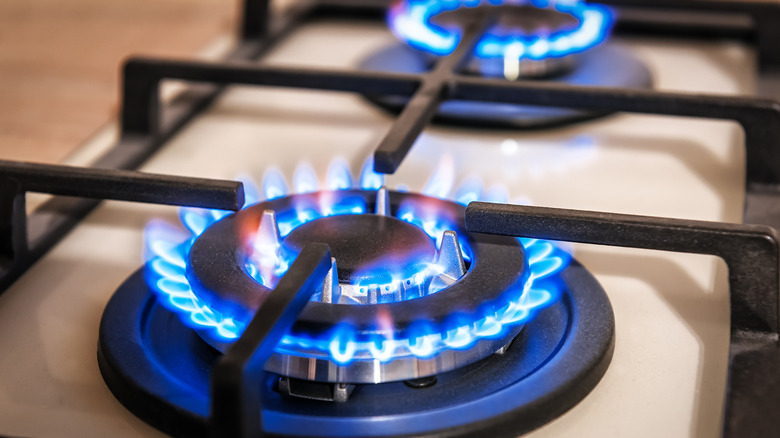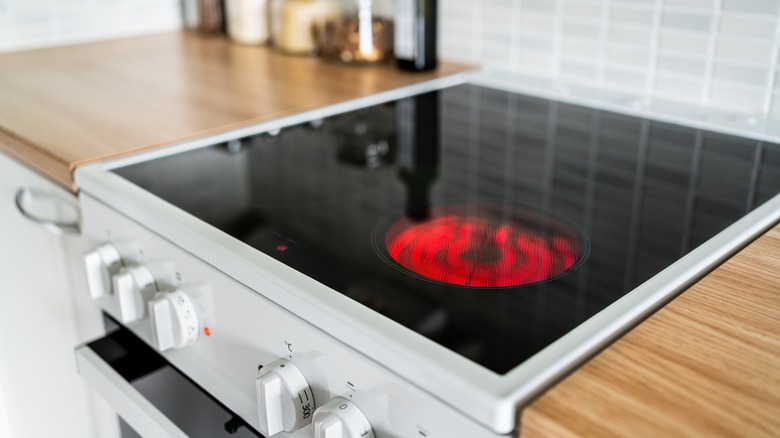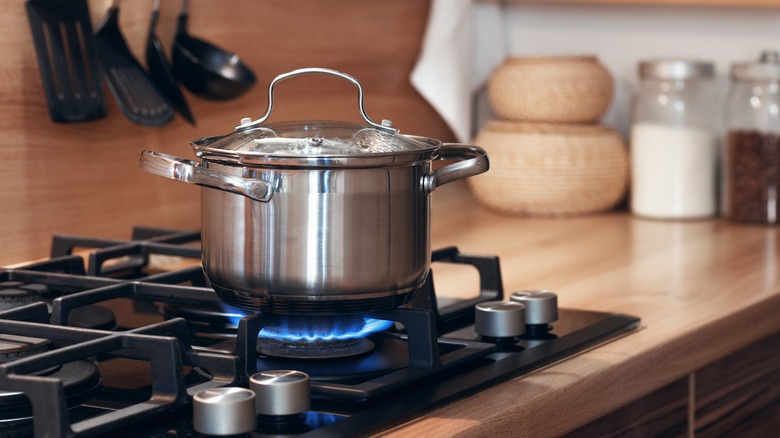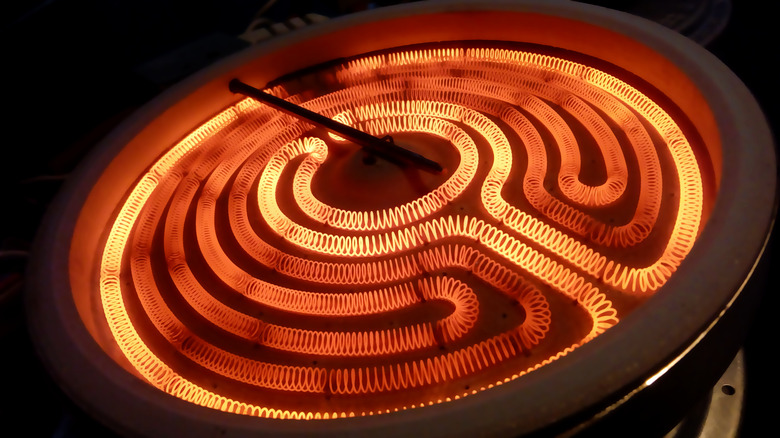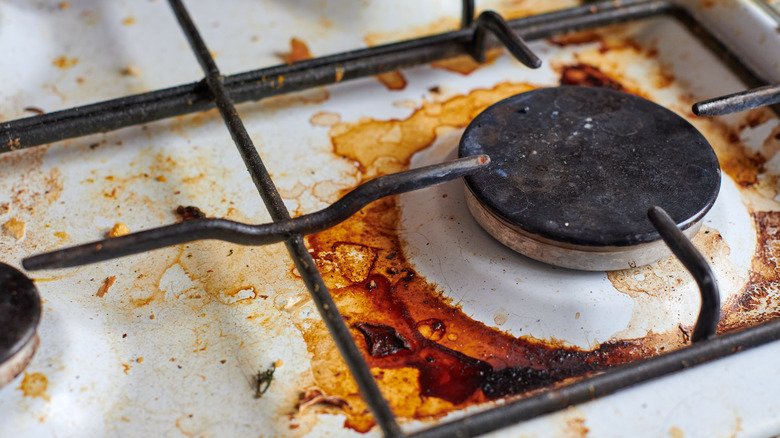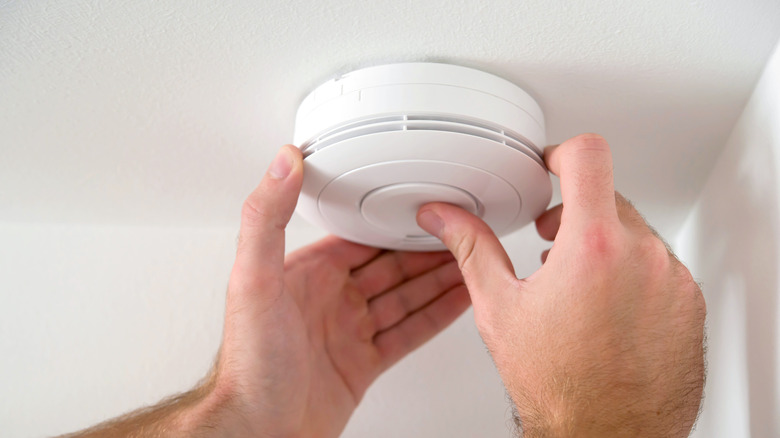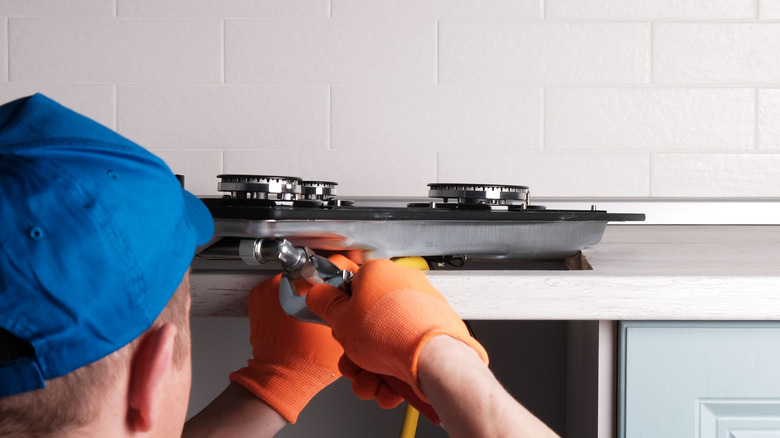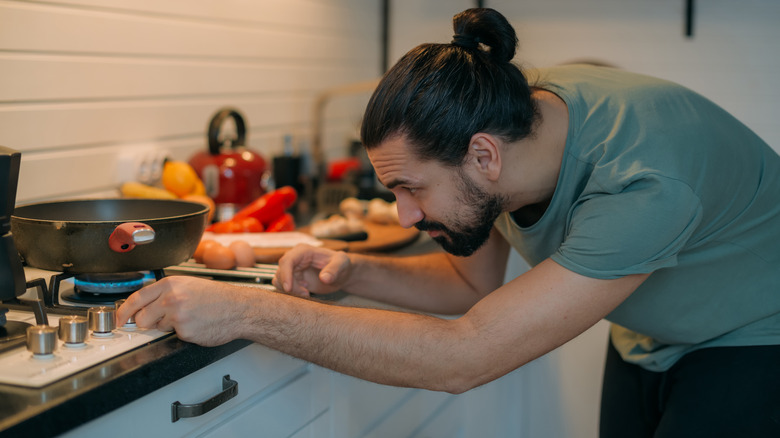Gas Vs. Electric Stoves: What's The Difference?
We may receive a commission on purchases made from links.
There are several factors to consider when purchasing a new kitchen stove. According to Consumer Reports, some of the most important considerations shoppers should make include the range width, the number of ovens, and the oven capacity. You may also be interested in finding a range that offers special features, such as expandable heating elements, warning lights when the surface is still hot, a control lockout to prevent the burners from accidentally getting turned on, and even Wi-Fi connectivity allowing you to monitor the oven temperature, turn off a burner that was accidentally left on, and more.
However, before making any of these decisions, you'll first need to determine whether you want a gas or electric stove. While you may have a general understanding of each range type, some key differences can help you decide which fuel source is best for your home. Keep reading to learn more about these key differences in choosing between a gas stove and an electric stove.
How gas stoves work
Appliance Assistant explains how gas stoves work. The stoves connect to a gas line that allows gas to enter the appliance for cooking. The gas flows through a pressure regulator, which monitors and maintains appropriate pressure levels as the stove cooks food. Older gas stoves relied on a pilot ignition system. These models have a constant flame inside them, which would light the burners and help maintain the oven temperature. However, pilot ignition systems are rarely used anymore because of the potential safety hazard related to carbon monoxide poisoning posed to individuals within the home.
Modern gas stoves feature electronic ignition systems to minimize the risk of carbon monoxide poisoning. These systems heat up the ignitor with an electric current when a user turns on a burner. Other gas stoves may rely on a direct spark ignition system. Stoves with this type of ignition often light burners more quickly and can yield more precise oven temperatures.
How electric stoves work
According to MagikFlame, electricity heats the coils beneath the burners in an electric stove. The amount of electricity that passes through these coils controls the burner's temperature. Users can adjust the burner temperature using the knobs, often found along the front or rear of the stove.
Induction electric stoves also rely on electricity to heat the burners. However, these models work a bit differently. They are designed to be used with cookware made with magnetized copper, which helps heat the pot or pan much faster than would be possible with a standard electric cooktop. Within seconds, the magnetized coils in the cookware will cause it to be warm. Because of the way the heat transfers from the burner to the cookware on an induction stove, the stove's surface doesn't stay hot once the pot is removed. This can make it easier to quickly attend to spills on the stove's surface without worrying about burning yourself.
Pros and cons of gas stoves
As LeafScore shares, there are several benefits associated with cooking on a gas stove, which is why many professional chefs prefer them. One of the reasons many chefs and everyday cooks prefer gas stoves is because they allow the user greater control over the temperature. It is much easier to adjust the flame to simmer sauces or sear meats, and as any serious cook knows, the temperature is the difference between something being perfectly cooked or burned. Gas stoves are also better for people on a budget since they tend to use less energy than an electric stove, costing you less each month in utility charges.
However, even with the several benefits they offer, there are still some downsides you'll want to consider before purchasing a new gas stove. Gas stoves can also pose a potential health or safety risk to users since they can threaten the indoor air quality of a home. Gas stoves emit low levels of carbon monoxide and nitrogen dioxide. While only small quantities are emitted at a time, these gasses can accumulate in the home and be particularly troublesome for those with asthma and other respiratory issues.
When you have a gas stove, you'll need to have gas pipelines hooked up, and the final bill for that would likely outweigh its energy-saving benefits on your monthly bills. Also, when gas pipelines are on your property, you'll need to take extra precautions not to damage them when completing outdoor projects or landscaping.
Pros and cons of electric stoves
Electric stoves also have their own set of pros and cons, as Best Buy highlights. One benefit of choosing an electric stove is that they are much easier to install and set up than gas stoves. Compared to gas stoves that need to be hooked up to the gas line by a professional, electric stoves can be plugged in and ready to use almost instantly. Though, as GE Appliances points out, you'll need at least a 240-volt outlet for your stove (which you may already have if you currently have an electric stove).
Another benefit of electric stoves is that they are generally easier to clean than gas cooktops. Since they don't have range grates and dips and grooves, you can quickly wipe them down after cooking to clean up spills. Many home cooks also prefer electric ovens over gas ovens. They offer even more heat distribution than gas models and tend to perform better with making baked goods or roasting meats and vegetables.
Electric stoves are also seen as a safer option. They don't have an open flame and don't release carbon monoxide into the air. If you live in a home with small children, both of these are important things that could impact your decision.
Electric stoves are not without their faults, however. One of chefs' biggest complaints when using an electric stove is that they heat more slowly than gas models. This means that they can take longer to cook food or boil water. Electric stoves with a glass cooktop are also more prone to damage than the grates on a gas stove. As you'd likely guess, electric stoves require electricity to work, so you won't be able to use it if the power is out. Some older gas stoves that don't have electric igniters will work during a power outage.
Is a gas or electric stove more expensive?
Gas and electric stoves can both vary in cost based on the specific model and features you choose. However, according to Fixr, the average cost to purchase an electric stove is slightly cheaper than that of a gas stove. The average cost to buy a 5.2-cubic foot, single oven electric stove and have it installed in a home is between $660 and $700. For a 5.3-cubic foot, single-oven gas stove, you can expect to spend between $760 and $1,260, including installation.
However, there are other cost factors to consider with each stove type, beyond the initial purchase price. If you do not already have a gas line in place, installing the lines can be quite costly. According to HomeGuide, you can expect to spend between $200 and $300 for a gas main installation. Installing a natural gas line from the street to your home can cost $2,000 or more. The cost will be less expensive if you have an existing gas connection and just need to run a new line to where your stove will be hooked up. This service typically costs between $355 and $743.
There are also additional costs to consider with electric stoves. Constellation shares that electric stoves tend to cost about twice as much as gas stoves with an electric ignition to operate each month. Of course, this figure can vary based on cooking habits and other features of the stove, but the additional energy costs over several years of use can add up.
Is it easier to clean a gas or electric stove?
Cleaning a gas stove can be a bit more involved than cleaning an electric stove, particularly models with a glass cooktop. Maytag explains that there are several steps to follow when cleaning a gas stove. First, you'll need to remove the cast iron grates from the stove. Then, you can use a soft cloth or sponge with some dish soap to clean the burner caps and base. You'll want to take care to clean the notches in the base, called the ports, that work to distribute the flame out. A straight pin or unfolded paper clip can help with this step. Then, make sure the burner caps are dry and put them back over the base.
Finally, the grates will need to be cleaned. Use a non-abrasive sponge with warm and soapy water to scrub the grates and remove any stuck-on residue. Some gas stove grates can also be cleaned in the dishwasher, but you'll want to check the specific recommendations for your specific model.
Cleaning an electric glass cooktop is much more straightforward and less time-consuming. Pro Housekeepers recommends using a soft cloth to wipe down its surface after each use (once it has cooled). Then, depending on how frequently you use your stove, you'll want to give an electric stove a deeper cleaning about once a week. Apply your glass cooktop cleaner and use light pressure with a microfiber cloth to clean the stovetop. Avoid using anything abrasive, as it can scratch the glass surface.
Is a gas or electric stove safer?
While there can be risks associated with each type of stove, electric stoves are typically considered the safer option. According to Perfect Stove, if a gas stove is not installed properly, it could lead to a gas leak. A gas leak, in turn, could cause a fire or even an explosion. Even when they are professional and properly installed, there is still some risk associated with using a gas stove. They can emit low levels of carbon monoxide into the home. Even if just a small amount is emitted at a time, the overall level in the house could become too high over time. This can pose a serious health risk for the individuals in the home.
According to the United States Consumer Product Safety Commission, an average of 170 people die each year due to non-automotive carbon monoxide poisoning. Malfunctioning gas ranges contribute to this number. Lower levels of carbon monoxide may not be deadly, but they can still cause a range of side effects, including headache, dizziness, nausea, fatigue, and shortness of breath. With higher levels of carbon monoxide, more severe symptoms, such as vomiting, confusion, loss of consciousness, and even death, are possible.
If you choose to purchase a gas stove, some tips can help you minimize the risk of carbon monoxide poisoning. These include hiring a professional to install and service the stove, installing a carbon monoxide alarm in your kitchen, not covering the bottom of the oven with aluminum foil, and never trying to use the gas stove to heat your home.
Do gas or electric stoves last longer?
Gas and electric stoves have a similar lifespan. However, according to HomeServe, gas ranges tend to last for an average of two years longer. They have an average lifespan of 15 years, compared to the 13-year average lifespan of an electric stove. Regardless of the type of stove you choose, Consumer Reports shares that there are measures you can take to extend its lifespan. One important thing to do is to ensure that any spills are promptly cleaned up after the surface cools. When the spills are left to sit, they can cause damage to an electric cooktop or clog the ignition parts of a gas stove.
It is also important to keep the oven clean when you want to make your stove last as long as possible. Use a sponge to clean up spills inside the oven after it cools. If offered by your model, the shorter speed-cleaning cycle can also be effective in keeping the oven clean and minimizing the frequency with which you'll need to employ the full self-cleaning cycle.
Is it easier to install a gas or electric stove?
Installing an electric range is more straightforward than installing a gas stove, and many homeowners can complete the task themselves. According to Natural Handyman, freestanding and slide-in electric ranges are pretty simple to install. They require a properly-sized opening (which may already be present if you're replacing your existing stove with a model that is the same size.) Freestanding ranges can also be placed at the end of a row of cabinets, but slide-in models must go between them because they do not have finished sides.
Before installing an electric stove, it is important to ensure you have the correct type of outlet to use. You'll need a dedicated 240-volt circuit with a 40- or 50-amp rating. The junction box for the circuit must be within 4 feet of the range. If you're not sure that the existing wiring meets these requirements, it is best to hire a licensed electrician to check your wiring and make any necessary upgrades.
All Dry USA stresses the importance of hiring a trained professional to install a gas stove. Without proper training on installing gas appliances, you run the risk of making a mistake that could lead to a gas leak or other safety hazards. When installing a gas stove, the professional you hire must disconnect the gas line, clean all connections, and work to prevent leaks by wrapping the gas pipe.
A dual fuel range allows you to enjoy the benefits of cooking with both gas and electricity
If you can't decide whether a gas or electric stove is right for you, there is a third option to consider. A dual fuel range may be the perfect fit for your kitchen. KitchenAid explains that these models feature a gas cooktop with an electric oven. Their design allows you to enjoy the faster cooking speeds and greater temperature control that gas ovens offer. At the same time, you also get to take advantage of the drier heat electric ovens deliver for browning and baking foods.
This may be a good option for you if you already have gas hookups in your home. If you do not already have a gas connection, you'll need to have one installed, which, as described above, can be pretty expensive. If you're used to cooking with a gas stove, it may also take a while to get accustomed to the slower pre-heating times of an electric oven.

